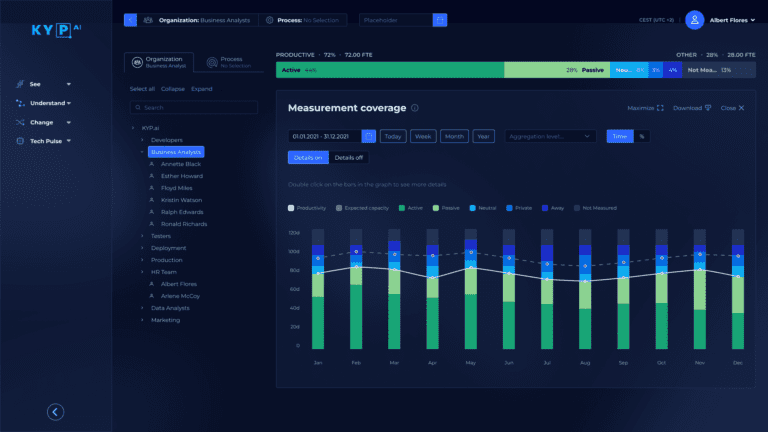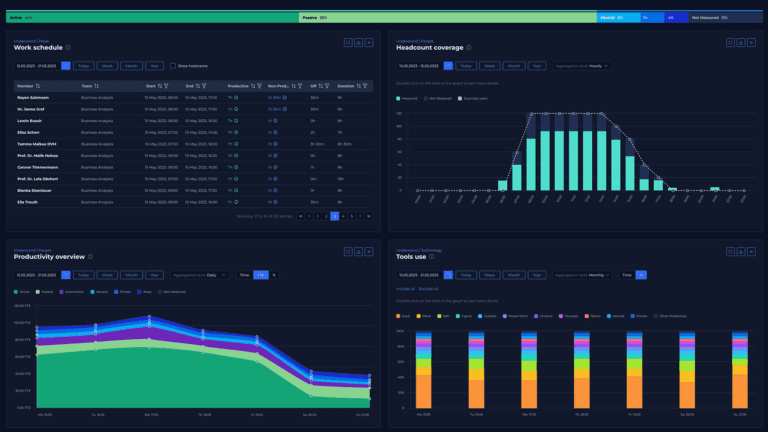Why Business Process Monitoring is a Catalyst for Operational Excellence
Processes are the silent support system of every organization. Whether handling customer queries, managing inventory, or onboarding new hires, processes dictate how efficiently a business runs. Even the most well-designed processes need regular audits and updates. They require visibility and intelligent intervention to remain effective.
A clear understanding of your processes gives you the power to fix inefficiencies and build on what’s already working. Real-time visibility helps you catch delays early, minimize rework, and stay aligned with compliance needs. It enables confident decision-making and creates space for continuous improvement.
This is where business process monitoring changes the game. It turns routine workflows into agile operations that evolve. Below, we unpack the role of process intelligence in process optimization, the challenges it helps overcome, and how technology can enable an easy and intelligent transformation.
What is Process Monitoring?
Process monitoring brings operational visibility. This is achieved by creating a living, breathing dashboard of your business activity that helps you act in the moment. It also captures and analyzes historical patterns, letting you see, understand, and improve ways of working.
BPM continuously documents and analyzes how a process performs across various stages, departments, and systems. Its goal is to help you improve business outcomes. This may be through automating repetitive processes, removing bottlenecks, or creating benchmarks and optimizations that can improve results.
Process monitoring spans core business workflows, long-tail repetitive tasks, and support operations, creating end-to-end visibility into how work flows from the beginning to the end of the process across teams, systems, and stages. This all-encompassing view lets you identify the root cause and provides recommendations on how to solve and prevent it from recurring.
Benefits of Monitoring for Process Optimization
- Establishing Baselines and KPIs
Before making any improvements, it is essential to establish your baseline. What is currently happening, and what are the expectations or potential areas for improvement? By utilizing historical and real-time data, business process monitoring helps define and benchmark key metrics, such as cycle time, cost per transaction, error rates, and throughput.
For example, Business Inheritance Logic from KYP.ai, contextualizes your processes without manual effort, piecing together business processes from start to finish. This could be by a business ID, case/claim number, or other common denominator identifier.
In turn, you have better benchmarks and best practices in a structured, clear format. In turn, you can set realistic targets aligned with your business goals—reducing turnaround time, improving quality, or maximizing automation. Platforms like KYP.ai take this even further by capturing the digital behavior of users, systems, and tasks, revealing high-performing patterns you can replicate at scale.
- Proactive Issue Resolution
Monitoring provides live insights that keep leaders ahead of problems—no more relying on stale reports or intuition. As soon as deviations from the SOP occur – maybe an SLA is missed, or a process stalls, monitoring systems flag them instantly.
AI-powered platforms like KYP.ai reduce noise by filtering out false positives. In addition to alerts, you also receive intelligent recommendations on what and how to address them. That way, teams spend less time troubleshooting and more time driving meaningful results.
- Continuous Improvement and Optimization
Monitoring is the foundation for continuous process refinement. As your business evolves, so do your workflows. Monitoring helps identify what needs to be fixed, what can be improved, and where automation can have the greatest impact.
With KYP.ai, these insights don’t just sit in a dashboard. They become clear, actionable priorities that teams across departments can implement quickly and effectively. Taking it even further, you can use Concierge, which is a domain-specific LLM that gives you access to an AI-powered chat where you can ask about your data.
Challenges in Process Monitoring

While process monitoring is a valuable tactic for most businesses, there are a few challenges to understand and avoid before you begin.
- Data Quality and Integrity
Poor data is one of the biggest threats to effective monitoring. If your inputs are broken—missing fields, inconsistent formats, or outdated logs – your analysis will be flawed. Garbage in, garbage out.
KYP.ai helps overcome this with robust pipeline validation, schema recognition, and automatic error handling. This means that the data you see is data you can trust, because it’s capturing it at the source via desktop.
- Integration with Distributed Systems
Most businesses today operate in complex, hybrid environments. Processes don’t live in one place – they span CRMs, ERPs, HR tools, and customer service platforms. Without a centralized view, it’s easy to miss the forest for the trees. Most process mining software lets you view work across a single system. While this perspective can still have some value, it lacks the scalability for optimization across an entire business process and leaves money on the table.
KYP.ai provides unified monitoring across all systems without disrupting your operations- no ripping and replacing – instead, it offers intelligent insights layered across your existing stack.
- Automation Complexity
As businesses scale automation, maintaining visibility becomes increasingly challenging. How do you monitor something that changes every week? What happens when a bot breaks or an update causes workflow failure? How about a change in staffing or staff call-outs?
The solution is dynamic adaptability. KYP.ai continuously captures your workflows and makes them available via low-code and no-code environments. This enables you to embed monitoring as your automation grows, without breaking what’s already working.
Steps to Implement Effective Process Monitoring
- Define Clear Objectives and KPIs
Set KPIs that map directly to your business priorities. These should be specific, measurable, and time-bound. For example: Reduce average case handling time by 15% in 90 days.
- Set Up Robust Data Collection Mechanisms
Automate data capture across your workflows and digital touchpoints. Integration tools ensure that data flows smoothly, consistently, and at scale.
- Apply Real-Time Data Analytics
Use process intelligence platforms like KYP.ai to process and analyze raw data in real-time. Dashboards should provide both live insights and historical reporting.
- Leverage Pre-Built Dashboards
Create role-specific dashboards tailored to different user types, such as finance teams, operations leads, and compliance officers. Let visuals drive attention to trends, alerts, and anomalies. Conversational GenAI interfaces make querying these dashboards user-friendly and valuable.
- Define Thresholds and Configure Alerts
Let AI recommend intelligent thresholds that define your “happy path” and flag deviations when they occur. Alerts should be actionable, not just informational. Use human-in-the-loop feedback to strike the optimal balance of data and human oversight.
- Establish Governance and Ownership
Assign monitoring oversight and clear roles and responsibilities. Who owns which metric? Who responds to alerts? Make governance part of your monitoring DNA.
- Enable Continuous Optimization
Schedule regular reviews. Ask, “Are we improving?” Use insights to refine strategies and implement minor, high-impact tweaks on a regular basis.
Key Metrics for Process Monitoring (Expanded)
To truly optimize, you need to monitor the right things. Here are some of the most powerful metrics used in business process monitoring:
- Cycle Time
This measures the total time from the initiation to the completion of a process. High cycle times usually indicate unnecessary delays or inefficient handoffs.
- Rework Rate
This shows you how frequently tasks need to be redone, often due to errors, missing data, or unclear inputs—a high rework rate signals broken, misunderstood, or poorly documented/trained processes or teams.
- Touchless Completion Rate
How many processes are completed without human intervention? This is a direct measure of your automation maturity. Higher rates mean higher efficiency.
- Process Throughput
How many times can your process be completed in a given time frame? Throughput helps you measure capacity and identify when scaling is necessary.
- First Call Resolution (FCR)
FCR measures how often a query is resolved in a single service. It’s closely tied to customer satisfaction and a customer service agent’s efficiency.
- Customer Experience Metrics
Metrics like average resolution time, Net Promoter Score (NPS), and satisfaction ratings show how your internal process quality is perceived by your customers. If customers are frustrated, something in the process is broken.
KYP.ai tracks all these metrics, and more, in real-time. The platform highlights what’s underperforming and identifies where improvements would yield the highest ROI.
Why KYP.ai is Purpose-Built for Process Intelligence
Unlike traditional monitoring tools that focus on either logs or user actions, KYP.ai provides a holistic view of both datasets. It brings together data from systems, workflows, and people, without requiring invasive integrations or multiple months of lengthy implementation.
It works as an intelligent layer on your stack, observing digital behaviors and translating them into clear, contextual insights. And thanks to its AI-driven engine, those insights come with suggestions, alongside highly customizable dashboards.
KYP.ai reveals your potential for improvement and provides the fastest way to address it. This gives business leaders a direct line from visibility to value.
Conclusion: Make Monitoring the Engine of Your Process Strategy
Process monitoring is a strategic superpower. It helps businesses see clearly, move faster, and improve continuously. It bridges the gap between data and direction, between insight and action.
With platforms like KYP.ai, process intelligence becomes the heartbeat and the nervous system of your operations. You understand, predict, optimize, and most importantly, you lead.
FAQs
1. Why is business process monitoring essential for optimization?
Business process monitoring provides real-time visibility into how processes function. Businesses can respond faster and more effectively by continuously tracking KPIs and surfacing inefficiencies early. It enables proactive improvements, prevents minor issues from snowballing, and keeps workflows aligned with strategic goals. Ultimately, it turns your operations into adaptable performance engines.
2. How does KYP.ai help in real-time process monitoring?
KYP.ai connects with your existing systems, tools, and user workflows without complex integration. It captures digital activity across teams and processes, then applies AI to uncover patterns, friction points, and automation potential. Real-time dashboards and intelligent alerts enable leaders to make informed, data-driven decisions quickly. The result is complete transparency and faster optimization, without disrupting daily operations.
3. What KPIs should we track during process monitoring?
It depends on the process, but some universal KPIs include cycle time, rework rate, process throughput, and touchless completion. For service functions, metrics like first call resolution (FCR) and customer satisfaction (e.g., NPS or resolution time) are crucial. These indicators help identify where time and resources are lost and where performance is peaking. Tracking the right KPIs is key to measuring and improving efficiency.
Additional metrics like ENPS (employee NPS) scores, top-and-bottom-line savings, and resource utilization are also important metrics and available within the KYP.ai platform.
4. Can process monitoring identify automation opportunities?
With KYP.ai, process monitoring reveals repetitive, high-volume tasks that can be automated. KYPatterns mine your operational data, offering pre-calculated business cases to give you data that you can use to decide what (or what not) to implement. It also highlights where existing automations may not be delivering the expected value. By combining usage data with performance metrics, businesses can pinpoint exactly what, when, and where to automate. This prevents wasted effort, minimizes risk, and ensures automation drives positive impact.
5. Is process monitoring only for large enterprises?
While large companies may have more complexity to manage, smaller and mid-sized businesses can benefit as much, if not more. Process monitoring enables organizations to work more effectively by identifying inefficiencies, providing more data for informed decisions, and optimizing workflows. Whether scaling fast or evolving existing operations, visibility into your processes is essential, regardless of company size.
Discover Your Productivity Potential – Book a Demo Today
Book Demo








